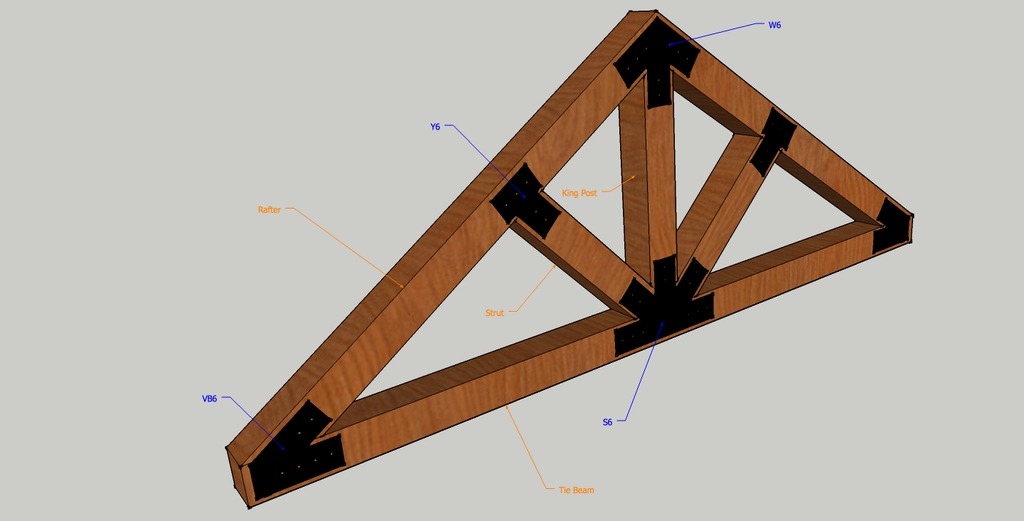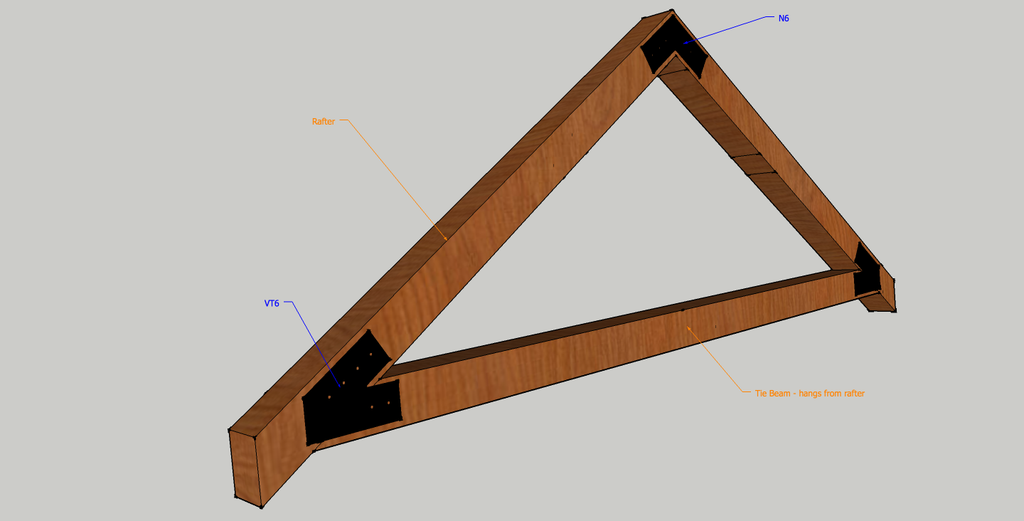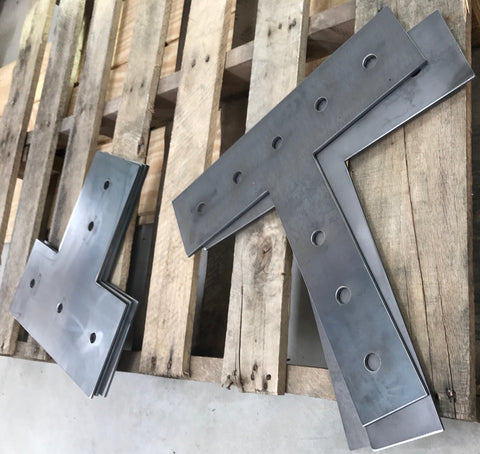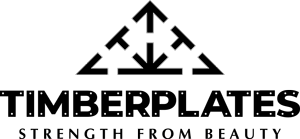How it Works
The plates you need depend on the truss you are building. Use the examples below to guide you in your plate selection. Some things to keep in mind when ordering plates:
- Plates that touch roof members need to be matched to the pitch of your roof. Our stock designs fit a variety of pitches. We have designs for most plates for pitches between 4/12 and 12/12. If you need a plate in a specific pitch and our web site does not have it listed, contact us and we can easily and quickly add that option.
- Choose a material thickness that suits your need. Purely decorative plates can be 3/16". Plates that are expected to provide structural support should usually be 1/4". Note: Customer takes all responsibility for structural suitability of timber connector plates. A qualified engineer should always be consulted to ensure structural integrity.
- Plates are usually ordered in pairs to "sandwich" the timber. You can save money and time on purely decorative applications by lags screwing the plates to the timber rather than through-bolting them.
- Threaded rod cut to length with fender washers and nuts makes hardware symmetrical. Bolts result in bolt heads on one side, nuts on the other.
- If you are building a style of truss that requires a different style of plate, just call and we can discuss custom designs. Often these custom designs can be done for free. Changing bolt hole patterns, changing widths and removing spokes can often be done from verbal quotes in minutes.
- For orders over 500 lbs custom shipping quotes can reduce cost. Contact us for details.
Example King Post Truss with Struts
This is the traditional "complete" king post truss shown here using our Massif plates. A truss like this would require 2 W6, 2 S6, 4 Y6, and 4 VB6 plates.

Example King Post Truss without Struts
A king post truss does not have to have interior strut members. In this configuration, again illustrated with plates from our Massif collection, the truss requires 2 W6, 2 T6, and 4 VB6 plates.

Example Truss without King Post
This truss has a modern flare. It omits the king post but has interior struts. Using plates from the Massif collection it requires 2 N6, 2 U6, 4 Y6, and 4 VB6 plates.

Example Truss without King Post or Struts
The simplest form of truss skips both the king post and the struts. It simply uses a bottom beam to hold the walls together and creates an open, airy look. It requires only 2 N6, and 4 VB6 plates.

Tie Beam Example
Trusses do not have to be used. Instead, rafters can simply be tied together using a tie beam. This is similar to the example above, but instead of the rafters sitting on the tie beam, the tie beam hangs from the rafters. Collar ties are examples of tie beams. VB plates are used in the example above, whereas VT plates are used for this approach. Trusses are usually built on the ground and raised as a unit. However, in this example the roof is usually framed first and the tie beam is then raised into place and connected to the roof. Again, using plates from the Massif Collection, this approach would require only 2 N6, and 4 VT6 plates.

What to Expect
Timber connector plates are heavy and shipping these plates requires substantial packaging. Our plates ship FedEx Freight and depending on the size and weight of the order will show up in heavy boxes, on pallets, or in crates. In most cases the buyer will be responsible for unloading and moving the plates.
Timberplates plates are all cut from unfinished mild carbon steel. Mild steel rusts so expect some superficial rust on your plates. In most cases you can ignore it and apply your finish right over it, but if you really want, take some steel wool or sandpaper to it and wipe it off.

Finishing Ideas
Finishing options vary depending on the desired look:
- Want a classic black iron look? Our matte black powder coat is gorgeous and one of the most durable finishes on the market. This is the preferred option for outdoor applications because of its UV stability.
- Looking for a DIY option? Prep the plates thoroughly by wiping with acetone or lacquer thinner. Let them dry and spray with some black Rustoleum or Krylon metal primer. Apply a top coat of Rustoleum or Krylon black spray paint for a durable attractive coating. Wear rubber gloves to ensure oils from your skin don't get onto the plates.
- Want an even more subtle look? Paint the plates and the hardware a terra cotta or brown color to match your timbers.
- Prefer an industrial, raw look? Our A36 steel comes with a thin gray layer of mill scale and will have silver grinder marks here and there. Wipe off the plates with acetone or lacquer thinner and seal the plates with a polyurethane clear coat.
- What about letting the plates rust naturally? This can be beautiful in the right application. Soak the plates overnight in vinegar, wipe down, then spray with a mixture of vinegar, salt, and hydrogen peroxide. The plates will form a beautiful rust patina naturally. Seal with polyurethane clear coat.
